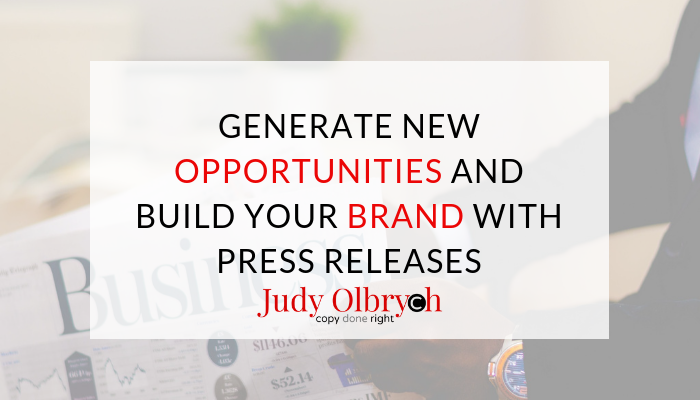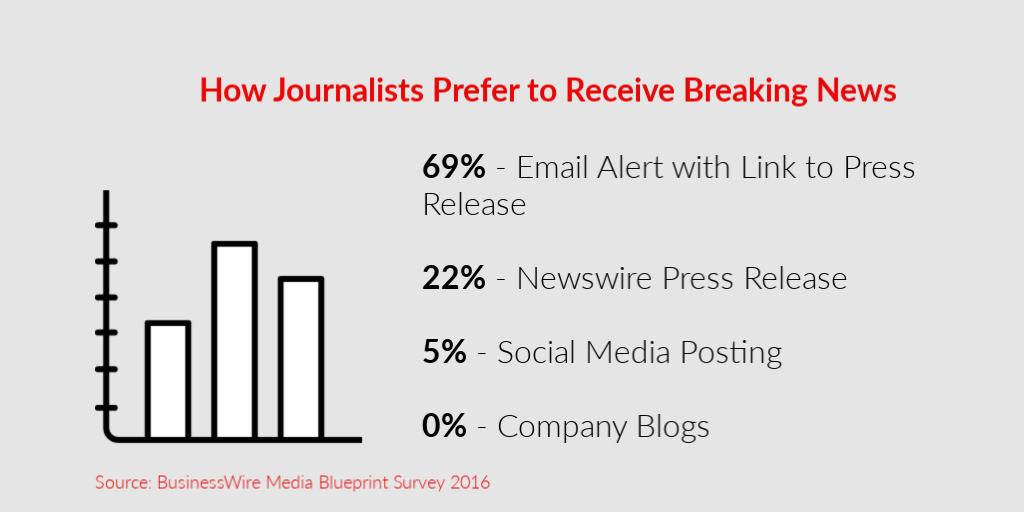How do you build a buzz and attract new opportunities for your brand fast … without hiring a PR department or spending 47 consecutive hours on Instagram?

The standard Press Release remains an easy and cost-effective tool for building your business – even in the age of Social Media.
Nine out of ten of journalists would rather receive breaking news from an organization through a Press Release than any other medium, according to Business Wire’s 2016 Media Blueprint Survey.
The study showed 69% of journalists prefer to receive an email alerts with links to a full press releases and 22% favored Newswire press releases. In contrast, only 5% chose social media postings and 0% said they preferred to receive breaking news on company blogs.
Distribute a Press Release, and you spark opportunities to bring attention, leads, and revenue to your business.

What is A Press Release and How Can It Grow My Business?
If you’ve never published a Press Release before, you may be wondering what they are and when to use them.
Businesses and organizations use these short, 1-2 page pieces to announce new structural changes, events, promotions, and more. A typical “reverse pyramid” format places the most important details at the top, so it’s easy for reporters to find information and quotes they need to build stories on tight deadlines.
The Oxford Dictionary of Marketing (2011), defines a Press Release as:
A short statement that outlines some newsworthy event or activity and that companies send to reporters and editors with the hope of getting press coverage. Press releases for television are often done on videotape and are now also released to online news agencies and newswires.
🗸 Press Releases make all your announcements, promotions, mergers, available to newspapers, TV stations, and online publications.
🗸 Press Releases build excitement, promote your brand and make it easy for future customers to find you when reporters include the backlinks to your website, product, or event.
🗸 When negative publicity is on the horizon, Press Releases give you the opportunity to announce a problem FIRST – from your perspective and with the language you choose.
Here are some of the ways Press Releases draw new and returning visitors to your doors, web pages, and event tables:
- Announce the opening of a new branch or store
- Name an event or expo you’ll attend – Let them know who’s speaking at the conference, where to find you, and what special deals you offer attendees
- Make a public announcement about new jobs available
- Tell potential customers about a new product or service you offer
- Promote a new publication
- Announce a merger with another company
- Reveal results of a recent study or survey
- Announce new appointments of new company leaders
- Tell about a new product feature
- Show a new use case for your software
- Celebrate a prestigious award your company, employee, or product has received
- Report a new partnership
- Promote a special offer or giveaway
- Update shareholders about a Quarterly Revenue Report
- Announce a significant donation or sponsorship for a cause or event important to your industry, company, or community

Anatomy of a Press Release
A Standard Press Release Contains 10 Elements.
The most important information is placed at the top, so it’s easy to find. It’s followed by quotes, supporting details, and a single call to action at the end.
1. The Magnetic Headline and Subheadline
The headline is the most important part of your Press Release. A strong title captures attention and compels readers to stay on the page. Don’t be clever at the expense being informative. Include keywords for search and the big idea of your Press Release.
The subheadline gives you a second opportunity to hook your reader. Include keywords to optimize for sitewide and internet searches.
Stuck on your headlines? Grab my Cheat Sheet for High Conversion Headlines in under 10 Minutes
2. Source, Date, and Time
Provide a contact name for reporters, bloggers, and publishers. Those wanting to expand the story will be able to reach out for additional details or quotes.
3. Location, Date, and Leading Sentences
The location and date of your story immediately precedes your first sentence. The opening sentence may stand alone or begin a short paragraph containing the most important facts of the press release.
4. First Paragraph – The Essentials
Your first paragraph gives reporters the 5 W’s: Who, What, Where, When, and Why. Keep your message clear and easy to summarize.
5. Second Paragraph – Context
Provide background for your announcement. For example, you might explain relevant policy changes, show how your product is part of an exciting new development in technology or health care, or refer to the fascinating story behind a new launch, product, or event.
6. Quote
Include one or two relevant quotes from business or industry leaders.
7. Supporting Details
Add supporting details and cite sources for your story as needed. Be specific. Use quotable numbers, in-house statistics, and fascinating facts.
8. Call to Action
Although Press Releases focus on information rather than sales, each typically ends with an invitation to take a specific action based on the content of the piece.
9. Boilerplate and Contact Information
Your boilerplate copy tells about your company and how you serve your clients/customers. It’s typically the same or similar copy pasted into each Press release. Follow with the name, email, and phone number for your media contact.
10. Eye-catching Graphics
A picture is worth a thousand words. Include 1-2 photos to share in the body of your release.
Ready to boost visibility, attract new audiences, and save time?
Judy Olbrych Copywriting LLC offers Press Release Writing Services. Contact Judy to learn more.
Anatomy-of-a-Press-Release
